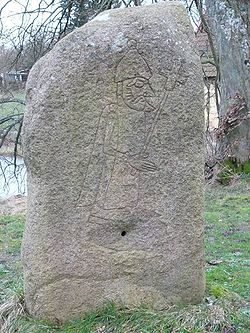- Sövestad Runestones
-
The Sövestad Runestones consist of a Viking Age image stone and memorial runestone found near Krageholm Castle, which is about two kilometers west of Sövestad, Skåne County, Sweden.
Contents
Sövestad 1
Sövestad 1, which is listed as DR 290 in the Rundata catalog, consists of a depiction of a man holding a cross on a pole. There are no runes carved on this stone. The inscription on the granite stone, which is 1.65 meters in height, was discovered in 1756 on the castle grounds when the stone was turned over.[1] The remains of a sword were also found under the stone.[1] Both of the Sövestad 1 and 2 stones are today raised at the castle.
Although located in Sweden, both of the Sövestad stones were given Danish Rundata designations because Scania was part of the historical Denmark.
Sövestad 2
The inscription on Sövestad 2, which is listed as DR 291 in the Rundata catalog, consists of runic text in the younger futhark carved within a serpent that curves to make four text frames and within a separate inner text band. The inscription is classified as being carved in runestone style Fp, which is the classification for inscriptions with text bands with serpent or beast heads depicted as seen from above. The granite stone, which is 1.5 meters in height, was discovered with the inscription side down in a grove near a lake on the castle grounds in 1757.[2]
The runic text indicates that the stone was raised as a memorial to a man named Bramr by his wife Tonna and son Asgotr. Bramr is described as being bæztr bomanna or "best of estate-holders" and mildastr mataR or "most generous with food." This description is consistent with generosity with food and feasting being a mark of power and renown in Viking Age Scandinavia.[3] Several other runestones also note persons who are generous with food, including inscription U 739 in Gådi, which similar to DR 291 describes a man as mildr mataR or "generous with food," Sm 37 in Rörbro which uses yndr mataR or "liberal with food," and Sm 39 in Ryssby, Sm 44 in Ivla, Sö 130 in Hagstugan, U 703 in Väppeby, and U 805 in Fröslunda, where men are described using a form of matar góðan or "free with food."[4][5]
Inscription
Transliteration of the runes into Latin characters
- × tuna × sati × stain × þansi × aftiR × bram × bunta : sin × auk × askutr × sunR × hans × han × uaR × bastr × bumana × auk × ¶ × miltastr × mataR[6]
Transcription into Old Norse
- Tonna satti sten þænsi æftiR Bram, bonda sin, ok Asgotr, sunR hans. Han waR bæztr bomanna ok mildastr mataR.[6]
Translation in English
- Tonna placed this stone in memory of Bramr, her husbandman, and (so did) Ásgautr, his son. He was the best of estate-holders and the most generous with food.[6]
Sövestad 3
Descriptions from the 1800s suggest that there was a third Sövestad stone, which has been given the designation DR 292, which was located near a gate in a fence, but this stone either has been lost or never existed. Any inscription that may have been on this stone was not recorded.
References
- ^ a b "Sövestad-billedsten". Danske Runeindskrifter. National Museum of Denmark. http://runer.ku.dk/VisGenstand.aspx?Titel=S%c3%b6vestad-billedsten. Retrieved 15 February 2011.
- ^ "Sövestad-sten 2". Danske Runeindskrifter. National Museum of Denmark. http://runer.ku.dk/VisGenstand.aspx?Titel=S%c3%b6vestad-sten_2. Retrieved 15 February 2011.
- ^ Christiansen, Eric (2006). The Norsemen in the Viking Age. Blackwell Publishing. pp. 143–146. ISBN 978-1-4051-4964-8. http://books.google.com/books?id=cvRyQD73lZAC&printsec=frontcover&source=gbs_ge_summary_r&cad=0#v=onepage&q&f=false.
- ^ Larsson, Patrick (2008). "Runes". In McTurk, Rory. A Companion to Old Norse-Icelandic Literature and Culture. John Wiley and Sons. pp. 403–426. ISBN 0-631-23502-7. http://books.google.com/books?id=Exp50zxE0FwC&printsec=frontcover&source=gbs_ge_summary_r&cad=0#v=onepage&q&f=false. p. 422.
- ^ Jansson, Sven B. F. (1964). "Runstenen i Ryssby kyrka (Sm 39)". Fornvännen (Swedish National Heritage Board) 59: 225–235. ISSN 1404-9430. http://fornvannen.se/pdf/1960talet/1964_225.pdf. Retrieved 5 August 2011. p. 230.
- ^ a b c Project Samnordisk Runtextdatabas Svensk - Rundata entry for DR 291.
Categories:- Runestones in Scania
- Picture stones
Wikimedia Foundation. 2010.


